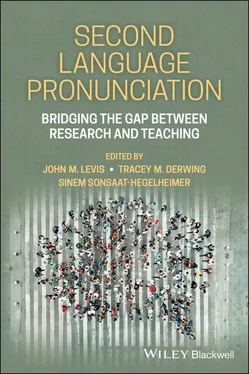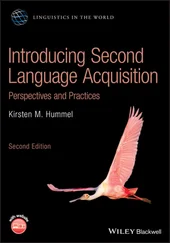Second Language Pronunciation
Здесь есть возможность читать онлайн «Second Language Pronunciation» — ознакомительный отрывок электронной книги совершенно бесплатно, а после прочтения отрывка купить полную версию. В некоторых случаях можно слушать аудио, скачать через торрент в формате fb2 и присутствует краткое содержание. Жанр: unrecognised, на английском языке. Описание произведения, (предисловие) а так же отзывы посетителей доступны на портале библиотеки ЛибКат.
- Название:Second Language Pronunciation
- Автор:
- Жанр:
- Год:неизвестен
- ISBN:нет данных
- Рейтинг книги:5 / 5. Голосов: 1
-
Избранное:Добавить в избранное
- Отзывы:
-
Ваша оценка:
- 100
- 1
- 2
- 3
- 4
- 5
Second Language Pronunciation: краткое содержание, описание и аннотация
Предлагаем к чтению аннотацию, описание, краткое содержание или предисловие (зависит от того, что написал сам автор книги «Second Language Pronunciation»). Если вы не нашли необходимую информацию о книге — напишите в комментариях, мы постараемся отыскать её.
Second Language Pronunciation: Bridging the Gap Between Research and Teaching
Second Language Pronunciation: Bridging the Gap Between Research and Teaching
Second Language Pronunciation — читать онлайн ознакомительный отрывок
Ниже представлен текст книги, разбитый по страницам. Система сохранения места последней прочитанной страницы, позволяет с удобством читать онлайн бесплатно книгу «Second Language Pronunciation», без необходимости каждый раз заново искать на чём Вы остановились. Поставьте закладку, и сможете в любой момент перейти на страницу, на которой закончили чтение.
Интервал:
Закладка:
Chapter 5: Making the teaching of suprasegmentals accessible ( Mary Grantham O’Brien , University of Calgary)
Teachers regularly report that suprasegmentals are hard to teach. They are hard for teachers to understand, hard to hear, and hard to explain. Innovations in the teaching of pronunciation require that description of suprasegmentals be accessible to teachers first of all, and that, second, activities and approaches to teaching be developed that make learning of suprasegmentals accessible to L2 learners. This chapter addresses these two issues.
Chapter 6: Classroom research for pronunciation ( Veronica Sardegna , Duquesne University and Alison McGregor , Princeton University)
Understanding why some approaches to pronunciation teaching are more or less effective requires that we understand the constraints of classroom instruction for student learning at different levels of proficiency, for different ages, and for different learning goals. This chapter examines how variables of classroom instruction (teachers, learners, features, teaching techniques) can be studied.
Chapter 7: Using technology to explore L2 pronunciation ( Dorothy Chun , UC Santa Barbara and Yan Jiang , Shanghai Jiao Tong University)
Pronunciation learning and teaching should be based, at least partially, on authentic language use, both in the types of production typical of L2 learners and in the models that learners are provided. This topic explores the promise of technology for L2 pronunciation teaching and learning, including issues related to materials development, learning and teaching priorities, and the ways that pronunciation functions in authentic speech.
Chapter 8: Beyond controlled, guided, and free practice: Teaching pronunciation effectively via a coaching model ( Donna Brinton , Educational consultant , Michael Burri , University of Wollongong & Amanda A. Baker , University of Wollongong)
The authors present a holistic view of effective pronunciation, taking into account the knowledge base of practitioners (Baker & Murphy, 2011) and the need to attend to additional (i.e., learner and/or learning-specific) variables when designing effective practice. Unique to this re-definition is the application of a coaching approach to pronunciation teaching (Baker, 2021), adapted from work in the field of psychology (Kauffman, 2010); this approach considers the additional situational, cultural, and linguistic variables critical to effective delivery.
Chapter 9: Effective feedback for pronunciation learning ( Graeme Couper , Auckland University of Technology)
L2 pronunciation learning, whether face-to-face or online, requires feedback on the success of perception and production. Such feedback needs to address both form and function of the errors, and it needs to be understandable to the L2 learners. It should also be delivered in the most effective manner so that L2 learners are most likely to improve. This topic addresses best practices in providing feedback on L2 pronunciation.
Chapter 10: Pronunciation assessment in classroom contexts ( Daniel Isbell , University of Hawaii & Mari Sakai , Georgetown University)
The future of pronunciation teaching is closely connected to the role of pronunciation in spoken language assessment. This chapter looks at how classroom and high-stakes pronunciation assessment can inform classroom practice and materials development.
Chapter 11: Pronunciation in varied teaching and learning contexts ( Mark Tanner and Lynn Henrichsen , Brigham Young University)
The authors examine how pronunciation teaching and learning can be flexibly adjusted to different teaching contexts in which constraints of time, expertise, curricula, and confidence make the teaching of pronunciation more challenging. Included in the chapter are discussions of priorities, outside practice, classroom and self-assessment, how listeners hear accented speech, and ultimate achievement.
Chapter 12: Pronunciation teaching in EFL K-12 settings ( Elina Tergujeff , University of Jyväskylä)
In immigrant-receiving countries, pronunciation problems among L2 learners in K-12 are uncommon, and in fact, often their L2 pronunciation is so good that it masks learners’ lack of language proficiency. However, in English as a Foreign Language (EFL) settings, learners may have limited exposure to various pronunciation models, and thus may require explicit instruction. Tergujeff explores the need for pronunciation instruction in EFL K-12 contexts.
Chapter 13: The laboratory, the classroom, and online: What works in each context ( Solène Inceoglu , The Australian National University and Ines Martin , US Naval Academy)
Pronunciation training studies take place in a variety of contexts, each with their own strengths and constraints. This topic looks at the pros and cons of each and how effective pronunciation training in one context can inform training in others.
Chapter 14: Models of English and teaching across varieties ( Lucy Pickering , Texas A & M, Commerce, and Meichan Huang , Syracuse University)
Pronunciation training typically privileges a small number of prestige varieties that may not be widely spoken in certain contexts. This creates an assumption that pronunciation learning involves learning and teaching a variety that may not be appropriate for a particular regional or social context. The authors examine new approaches to pronunciation variation for both perception and production.
Chapter 15 : Research-informed materials for pronunciation teaching ( Sinem Sonsaat-Hegelheimer , Iowa State University, and Shannon McCrocklin , Southern Illinois University)
At the heart of pronunciation teaching are the materials used to teach pronunciation. Effective materials should demonstrate effectiveness in promoting learning, in creating interest for teachers, and should be based on research findings. This chapter provides an excellent rubric for teachers to use when choosing resources.
Critical Issues
Terminology
The chapters reflect different approaches to teaching pronunciation, nowhere more than in the varied terminology used by the authors. Although we considered requiring uniform terminology, we decided that it was more important that authors use the terminology that is theoretically and practically comfortable for them. As a result, some things may be unclear to readers who are unfamiliar with the different names for pronunciation features, especially for suprasegmental features. Suprasegmentals have a long history of being described and named in different ways, although for the purposes of this book, the differences are minor enough that they can be ignored by teachers. Nonetheless, it is helpful to list the terms used by various authors in Table 1.1. Thought groups refer to the speaker’s breaking speech up into logical and typically grammatical phrases of around five to seven words. They are the structure in which all suprasegmentals (except word stress) occur. Prominence refers to speakers’ highlighting particular words within a phrase to call attention to them (e.g., I HATE eating that stuff! ). Intonation refers to the movement of pitch across the thought group, and especially at the end of a phrase (e.g., Really? You hate it? , both with rising pitch). Rhythm refers to the patterns of strong and weak syllables across a thought group. A language like English has large differences in syllable length, while other languages, such as varieties of Chinese, do not. Finally, word stress refers to the dictionary patterns of prominence within a word. But since not all languages use stress, we also refer to word prosody and tone.
Читать дальшеИнтервал:
Закладка:
Похожие книги на «Second Language Pronunciation»
Представляем Вашему вниманию похожие книги на «Second Language Pronunciation» списком для выбора. Мы отобрали схожую по названию и смыслу литературу в надежде предоставить читателям больше вариантов отыскать новые, интересные, ещё непрочитанные произведения.
Обсуждение, отзывы о книге «Second Language Pronunciation» и просто собственные мнения читателей. Оставьте ваши комментарии, напишите, что Вы думаете о произведении, его смысле или главных героях. Укажите что конкретно понравилось, а что нет, и почему Вы так считаете.












